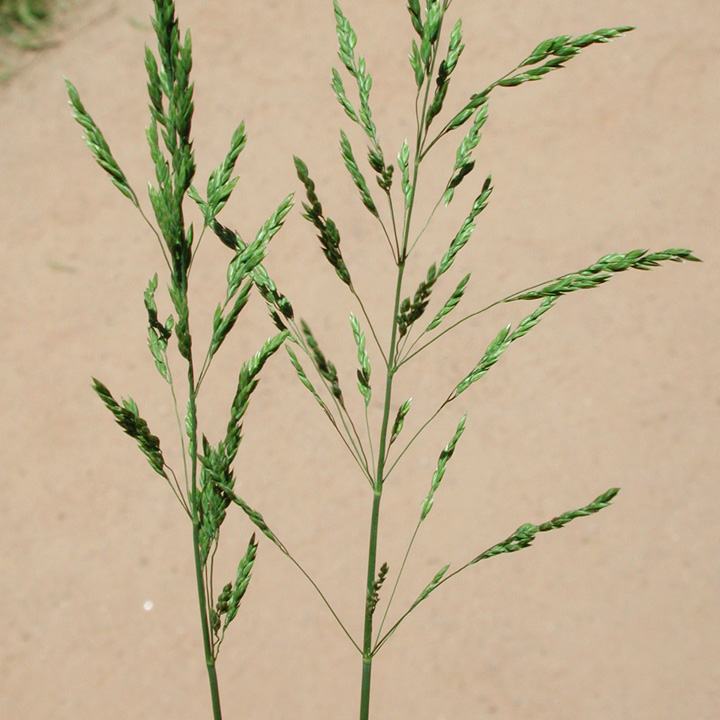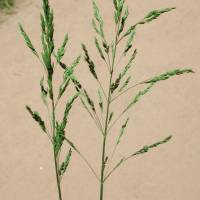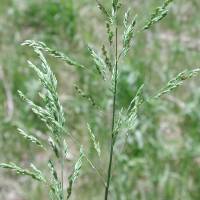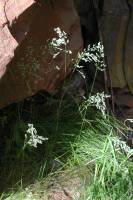Plants perennial; green or anthocyanic, sometimes glau-cous; extensively rhizomatous, densely to loosely tufted or the shoots solitary. Basal branching mainly extravaginal or evenly extra- and intravaginal. Culms 5–70(100) cm, erect or the bases decumbent, not branching above the base, terete or weakly compressed; nodes terete or weakly compressed, 1–2(3) exposed, proximal node(s) usually not exserted. Sheaths closed for 1/4–1/2 their length, terete to slightly compressed, glabrous or infrequently sparsely to moderately hairy, bases of basal sheaths glabrous, not swollen, distal sheath lengths 1.2–5(6.2) times blade lengths; collars smooth, glabrous; ligules 0.9–2(3.1) mm, smooth or scabrous, truncate to rounded, infrequently obtuse, ciliolate or glabrous; blades of extravaginal innovations like those of the culms, those of the intravaginal shoots sometimes distinctly narrower, 0.4–1 mm wide, flat to involute; cauline blades 0.4–4.5 mm wide, flat, folded, or involute, soft and lax to moderately firm, abaxial surfaces smooth, glabrous, adaxial surfaces smooth or sparsely scabrous, frequently sparsely hairy, hairs 0.2–0.8 mm, erect to appressed, slender, curving, sinuous or straight, apices usually broadly prow-shaped, sometimes narrowly prow-shaped, blades subequal, the middle blades longest, the flag leaf blades 1.5–10 cm. Panicles 2–15(20) cm, narrowly ovoid to narrowly or broadly pyramidal, loosely contracted to open, sparse to moderately congested, with (25) 30–100+ spikelets and (1)2–7(9) branches per node; branches (1)2–9 cm, spreading early or late, terete or angled, smooth or sparsely to moderately densely scabrous, with 4–30(50) spikelets usually fairly crowded in the distal 1/2. Spikelets 3.5–6(7) mm, lengths 3.5 times widths, laterally compressed, sometimes bulbiferous; florets 2–5, usually normal, sometimes bulb-forming; rachilla internodes usually shorter than 1 mm, smooth, glabrous. Glumes unequal to subequal, usually distinctly shorter than the adjacent lemmas, narrowly lanceolate to lanceolate, infrequently broadly lanceolate, distinctly keeled, keels usually sparsely to densely scabrous, infrequently smooth; lower glumes 1.5–4(4.5) mm, usually narrowly lanceolate to lanceolate, occasionally sickle-shaped, 1–3-veined; upper glumes 2–4.5(5) mm, distinctly shorter than to nearly equaling the lowest lemmas; calluses dorsally webbed, sometimes with additional webs below the marginal veins, hairs at least 1/2 as long as the lemmas, crimped; lemmas 2–4.3(6) mm, lanceolate, green or strongly purple-tinged, distinctly keeled, keels and marginal veins long-villous, lateral veins usually glabrous, infrequently short-villous to softly pub-erulent, lateral veins prominent, intercostal regions glabrous, lower portion smooth or finely muriculate, upper portion smooth or sparsely scabrous, margins narrowly to broadly hyaline, glabrous, apices acute; paleas scabrous, keels sometimes softly puberulent, intercostal regions narrow, usually glabrous, rarely sparsely hispidulous; anthers usually 1.2–2 mm, infrequently aborted late in development. 2n = 27, 28, 32, 35, 37, 41–46, 48–147.
Poa pratensis is common, widespread, and well established in many natural and anthropogenic habitats of the Flora region. The only taxa that are clearly native to the region are the arctic and subarctic subspp. alpigena and colpodea. Outside the Flora region, P. pratensis is native in temperate and arctic Eurasia. It is now established in temperate regions around the world.
Poa pratensis is a highly polymorphic, facultatively apomictic species, having what is probably the most extensive series of polyploid chromosome numbers of any species in the world. Poa pratensis is a hybridogenic species, i.e., it comprises numerous lineages with the same basic maternal genome, but different paternal genomes. The lineages are perpetuated by agamospermic and vegetative reproduction. Some major forms are recognized as microspecies or subspecies. These have some correlated ecological and morphological differences, but the morphological boundaries between them are completely bridged, and in some cases the taxa (e.g., subspp. agassizensis and colpodea) may represent environmentally induced plasticity.
Natural hybrids have been identified between Poa pratensis and P. alpina, P. arctica, P. wheeleri, and P. secunda. Many other artificial hybrids have been made; these involve many different, often distantly related, species. In addition, there are many cultivated forms of the species; these have been seeded widely throughout the Flora region for lawns, soil stabilization, and forage. Most cultivated forms favor subsp. irrigata morphologically; others tend towards subspp. pratensis and angustifolia, the latter occurring most commonly in xeric sites.
Poa rhizomata resembles P. pratensis, but has acute ligules and sparse inflorescences, florets that are usually unisexual, and generally larger spikelets; Poa macrocalyx looks like a robust P. pratensis with large spikelets, and lemmas and paleas that are generally hispidulous between the veins and palea keels. Poa confinis also resembles P. pratensis, but differs in having glabrous or sparsely hairy lemmas, and diffusely webbed calluses.
Frequent to common in all of the limestone areas of the state and rare or absent from the areas of acid soil. It is our principal pasture grass and is found almost everywhere, often as a weed in gardens. This species is here regarded as a native and by others as introduced into Indiana. See the discussion in Deam's Grasses of Indiana.
Common Name: Kentucky bluegrass
Duration: Perennial
Nativity: Non-Native
Lifeform: Graminoid
General: Perennial grass with extensive creeping rhizomes; stems 5-70 cm, densely to loosely tufted, erect or with decumbent bases, slender and wiry, terete to weakly compressed in cross section.
Vegetative: Sheaths closed for a quarter to half their length, terete to slightly compressed; collars smooth, glabrous; blades numerous, soft, usually green, folded or sometimes flat, 1-3 mm broad, with two impressed parallel veins (-railroad tracks-) on the upper si
Inflorescence: Open pyramidal panicles 3-8 cm long, with slender spreading lower branches in verticels of 4 or 5; branches 2-9 cm, with spikelets crowded on the distal half; spikelets 3.5-6 mm, ovate, strongly compressed, green to purplish, with 2-5 florets; glumes unequal to subequal, strongly keeled, scabrous on midnerve; lemmas copiously long hairy at base, mostly pubescent on midnerve and marginal nerves.
Ecology: Found in moist to dry meadows, open woods, roadsides, and waste places from 3,500-11,000 ft (1067-3353 m); flowers May-August.
Distribution: Native in temperate and arctic Eurasia; established in temperate regions around the world; throughout the US and CAN.
Notes: P. pratensis, or Kentucky bluegrass, is an important cultivated pasture grass throughout North America. It occurs as a weed in anthropogenic habitats but has also become a permanent meadow grass at middle and high elevations in the Southwest. Similar to the native P. fendleriana but can be distinguished based on P. pratense-s folded (vs. involute) blades; more strongly rhizomatous, often turf-forming growth form; more open inflorescences with the spikelets crowded at the branch tips; and tufts of hairs at the base of the lemmas.
Ethnobotany: Unknown
Synonyms: None
Editor: SBuckley 2010, AHazelton 2015
Etymology: Poa comes from the classical Greek name poa, poie, or poia for "grass" or "pasture grass;" pratensis means growing in meadows.
Rhizomatous, forming a dense sod, or in tufts on long rhizomes in open ground; culms 3-10 dm; sheaths usually glabrous; blades soft, 2-5 mm wide, seldom narrower and involute; ligule shorter than wide; infl ovoid, fairly dense, with spreading or ascending branches, the lower mostly in sets of 5 or 4; spikelets 3-5-fld, with very short rachilla-joints; first glume 1.8-2.9 mm, the second 2.3-3 mm; lemmas distinctly 5-veined, thinly to densely hairy on the veins below but glabrous between them, webbed at base, the lowest 2.5-3.5 mm; anthers 1-1.4 mm; 2n=21-147. Moist or dry soil, avoiding acid soils and heavy shade, throughout the U.S. and far n., often cult. in lawns and meadows; in most of our range intr. from Europe, but probably native along our n. boundary and in Can. (P. angustifolia; P. subcaerulea) Some nematode-infested plants in the ne. part of our range have notably larger, 7-veined lemmas and often a reduced and stiff infl.
Gleason, Henry A. & Cronquist, Arthur J. 1991. Manual of vascular plants of northeastern United States and adjacent Canada. lxxv + 910 pp.
©The New York Botanical Garden. All rights reserved. Used by permission.






